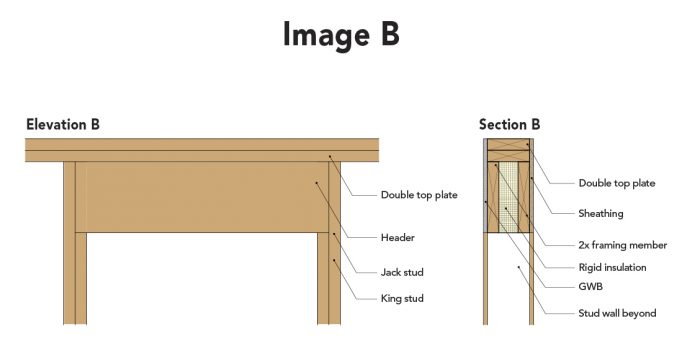
Light-frame construction has been used in the United States since the 1830s. It has evolved from balloon framing—with its long stud spans deemed a fire hazard—to platform framing, which is commonly used in residential building today. Like any system, it can be engineered for efficiencies. In recent years, traditional platform-framing techniques have matured to maximize a structure’s insulation capacity. This is called advanced framing or value-engineered framing, and it came about to enhance a building’s energy efficiency.
Improving thermal performance
One component of the wood-framed wall is the header, which is is a beam in the framing above windows and doors. It carries the loads from floors and roofs above to posts created by the jack and king studs that make the sides of the window’s or door’s rough opening. Below, a sill and cripple studs support the window.

The header’s function is to withstand the load requirements. Typically, it is made up of 2x framing members with plywood or OSB spacers (Image A). While structurally sound, the built-up header for most window and door openings is overdesigned in terms of structural capacity, and insufficient when it comes to thermal resistance. In other words, it is an inefficient component of wood-framed structures—one that presents an opportunity.

We capitalize on the fact that headers are overbuilt and sacrifice a small fraction of the structural integrity in order to beef up the insulating value. One way to do this is to remove one of the 2x members and its neighboring spacers and replace them with rigid insulation (Image B). The insulation can be installed in the middle of the header or, by grouping the two built-up members close together, to the interior or the exterior of the header.
Impact on sequencing
A key consideration…
Weekly Newsletter
Get building science and energy efficiency advice, plus special offers, in your inbox.

This article is only available to GBA Prime Members
Sign up for a free trial and get instant access to this article as well as GBA’s complete library of premium articles and construction details.
Start Free TrialAlready a member? Log in











6 Comments
Nice explanation with illustrations. Shows easy ways for traditional framers to improve the insulation value of walls around windows and doors.
Building a passive solar home in 1982, I used polyiso rigid insulation alongside doubled 2x headers (similar to Image C that uses engineered lumber). However, rather than use a 2x head plate to stretch all the way across the thickness of the wall below the header (Image C), I used a 2x3 (in a 2x6 wall) to close off the cavity at the bottom of the header, leaving a bit more insulation space below the header. Insulation is installed on the interior side, before drywall is installed, so there's no need for the framer to be involved with any insulation material.
There are two other alternatives that seem much better at increasing the thermal insulation in walls, that differ from typical framing practices: Box beams; and moving headers above the wall into the floor framing above the wall. Not sure why the author skipped these two options, other than keeping the article short and simple. (I wish I knew about them back in 1982.)
Box beams incorporate plywood across the face of the wall framing, incorporating tight nailing schedules, for using less lumber, and providing more space for insulation within walls. They are detailed in the code. (Some box beams require plywood on the interior of the wall, which would complicate drywall installation. Some box beams could use plywood wall sheathing as the plywood material as the exterior of the box beam, simplifying further.) But typically they may require an engineering stamp on plans. Inspectors and framers may not be familiar with box beam headers. And I wonder if all those extra nails create too many small thermal bridges to defeat some of the gains of eliminating headers. I wonder why box beams are not used more commonly, despite some planning work required.
Another alternative is to move the header up above the wall, incorporated in the flooring system (a "doubled " band joist in the areas where needed) to distribute the load outside of the opening below, without requiring headers or jack studs in the wall itself. That might be the best way to maximize insulation in the wall as well as simplify wall construction. However it would reduce insulation at the exterior edge of the floor, just like a header does, except it only adds one more 2x "header" to the existing band joist, rather than requiring two headers to be incorporated in the wall. And it typically would not be an option with a truss or similar roof system above the top story of typical platform framed building. I'd consider using this strategy myself for the bottom story of a two-story home or addition. Not sure why this approach has not become more common, as it seems as easy or easier than using headers and jack studs.
Not clear to me if the box beam approach would be more thermally efficient and easier, vs. incorporating the header in the flooring system above. But either would be another improvement over the typical framing done as illustrated in Image A.
Robert,
Good points.
What worries me about box beams is that they are not easily identifiable as being load-bearing, and so once buried in a structure could easily be cut or altered over time. I also have misgivings about relying on the exterior sheathing for the beam's integrity when it is so subject to damage or rot being part of the vulnerable outer layer of an exterior wall assembly.
I like the idea of incorporating the headers in the rim-joists. It's worth mentioning that the floor above the opening will need joist-hangers if this is done.
Both the first illustration in the article and your comment refer to the jack-studs as being eliminated, which is often not possible depending on the vertical loads on the header. With large openings more than one jack-stud may even be necessary.
Malcolm,
Yes good point about sheathing/ply more subject to deterioration from rot than 2x headers. Its possible that at a later date, people add awnings (or who knows what else) above a window, and reduce the structural capacity of a box beam. Maybe adding holes and hardware that can lead to water intrusion and rot. There are other alternatives that could add insulation/reduce thermal bridging besides modifying the structural framing.
Yes I remember the extra jack studs listed in the code for wide openings, surprising how many were required sometimes. So for moving headers up into the rim joist area, any extra jack studs would be extra studs required alongside the opening. Headers embedded in rim joists extend further on both sides of the opening as well, to distribute the load to more studs.
High performance walls with exterior rigid insulation or double wall construction would make the energy savings from modifying headers less important also. But headers moved into the rim joist area seems to have little downside (just those joist hangars).
Great article. Thanks!
Having trimmed out a lot of interiors I appreciate when there is a lot of meat around the interior of the window openings. It also helps provide attachment points for window coverings.
My general feeling about advanced framing is that I'd rather think about the wood structure with longevity and robustness as the primary concerns. If there is a bit of redundancy, that just makes it more resilient over time. Energy efficiency shouldn't come at the expense of those considerations.
I like B as with my exterior insulation jobs, the bottom is covered by the window buck.
Log in or become a member to post a comment.
Sign up Log in